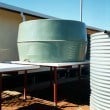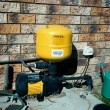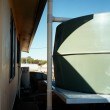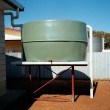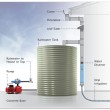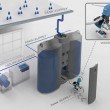B4.1 Quality of drinking water
People living in communities in rural and remote areas often do not have access to reliable and adequate sources of drinking water. In extreme circumstances, the water will not be safe to drink because it contains micro-biological contaminants that can cause acute gastric disease and other illnesses. When the water is safe to drink, it is called ‘potable’ water, but it still may taste ‘bad’. Poor tasting water can have an impact on health, nutrition and household costs because:
- cordial might be added to water to hide the bad taste or people might drink soft drinks instead of water, and both these products contain high levels of sugar
- if expensive bottled water or soft drinks are purchased, this reduces the money available to buy foods
- people may drink less fluid than required for healthy living.
In communities where the water quality is poor, consider ways to provide a small volume of quality drinking water to at least one tap in the kitchen, such as installing household filters or providing a small rainwater tank connected to the kitchen. A micro-reverse osmosis unit, which converts a small quantity of poor quality water into potable water, may be an option.
It should be emphasised that small-scale technologies such as micro-reverse osmosis units require regular maintenance to remain effective. Similarly, unless membrane and filter drinking water treatment devices are properly maintained they can become contaminated and may provide a false sense of security to residents trying to protect themselves from poor water quality.
Rainwater tanks are low-maintenance, requiring only simple skills when compared to other water system options and treatment methods. Although badly maintained rainwater tanks are potentially a health risk, well-maintained supplies can provide a valuable source of good quality drinking water for the life of the infrastructure (up to 15-20 years). In Australia, occupational health and safety regulations may make cleaning gutters that feed the rainwater tank more difficult and costly. Even where rainwater tanks cannot supply drinking water they can be a valuable source of water for fire fighting and safety, laundry areas, toilet flushing and clothes washing and for use on gardens to control dust.
Survey data shows that only 9% of houses surveyed had a rainwater tank and only 20% of the houses had effective guttering and downpipes, which could feed the rainwater tank.
For more information about water quality, see section C1.1 ‘Water quality and treatment systems’.
Design and Specification
Ensure
- B4.1.1.
tanks, water pipes and taps are located where they will not be at risk of damage by vehicles, mowers and weed cutters
- B4.1.2.
the roof area is kept clean by pruning any over hanging trees,
- B4.1.3.
evaporative coolers are not roof mounted, and if they are installed, divert overflow from discharging into the rainwater tank
- B4.1.4.
roof-mounted hot water systems do not discharge overflow water onto the roof or into the gutters
- B4.1.5.
a first flush diverter is fitted to the rainwater tank to divert the ‘first flush’ of dust polluted roof water away from the tank
- B4.1.6.
if the roof area is greater than 250m2, the diverter or a first flush tank, can handle large volumes of water with a capacity of approximately 200 litres
- B4.1.7.
the rainwater is filtered before it reaches the kitchen tap
- B4.1.8.
the main tap or outlet is slightly above the bottom of the tank (100mm) to allow any contaminants to settle and not pollute the water as it is taken from the tank
- B4.1.9.
a second outlet for cleaning is fitted at the bottom of the tank to allow it to be fully emptied and de-sludged
- B4.1.10.
fittings, taps, strainers and first flush diverters are accessible for maintenance and cleaning
- B4.1.11.
all openings are screened with mesh to keep out insects, frogs, birds and vermin
- B4.1.12.
water from the first flush diverter and tank overflow is directed to a garden area or a drain to prevent pooling that can lead to mosquito breeding or erosion
- B4.1.13.
a pressure pump, (or a hand pump for reduced maintenance), is fitted and has the capacity to supply drinking water to the house
- B4.1.14.
skills are available to provide maintenance for pressure pumps from the tank if they are to be fitted
- B4.1.15.
if the tank will be located on a stand, the stand has been designed and certified by an engineer to suit the soil and wind conditions
- B4.1.16.
the rainwater tank is secure and ‘tied down’ in high wind areas, remembering that it may not always be full of water
- B4.1.17.
a non-return valve is fitted if the tank’s water is connected to a mains water supply
- B4.1.18.
the house has a back-up drinking water option in case the tank becomes contaminated, is taken off line for cleaning and maintenance, or if power is not available to an electric pressure pump; options could include a second tank or mains water connection.
- B4.1.19.
if fitting a water filter - the type of filter or treatment system that is specified will actually improve the water quality, for example, the filter will remove the pollutants making the water taste bad or will remove any bacteriological contaminants
- B4.1.20.
if fitting a water filter - the filter or treatment system is placed in an accessible position to allow cartridges to be easily replaced and to enable the filter to be maintained
- B4.1.21.
if a water filter is fitted - replacement cartridges and parts are available locally and are affordable
- B4.1.22.
if any part of the rainwater system depends on electricity, such as a pressure pump, there is sufficient treated water stored for the household to use during a power outage, or there is an alternative water supply, such as mains water or direct access to the rainwater tank outlet.
Consider
- a gravity system rather than a pump system for simpler maintenance where capacity of drinking water is less critical
Real world examples of Solutions
- B4.1.1.
Quality control
- the size, material and location of the rainwater tank is specified

- COMPLETED DESIGN & SPECIFICATION
AT HANDOVER
- COMPLETED DESIGN & SPECIFICATION
- the rainwater tank overflow outlet and inlet are specified as screened, and the outlet point, tap, and cleaning point are noted

- COMPLETED DESIGN & SPECIFICATION
AT HANDOVER
FINAL COMPLETION
- COMPLETED DESIGN & SPECIFICATION
- all gutters and downpipes are specified with sizes falls and locations

- COMPLETED DESIGN & SPECIFICATION
DURING CONSTRUCTION
AT HANDOVER
FINAL COMPLETION
- COMPLETED DESIGN & SPECIFICATION
- the rainwater tank first flush diverter is specified and the volume of water diverted noted

- COMPLETED DESIGN & SPECIFICATION
AT HANDOVER
FINAL COMPLETION
- COMPLETED DESIGN & SPECIFICATION
- the rainwater tank stand structure or base is specified

- COMPLETED DESIGN & SPECIFICATION
DURING CONSTRUCTION
AT HANDOVER
FINAL COMPLETION
- COMPLETED DESIGN & SPECIFICATION
- any water treatment system from the rainwater tank is specified and located

- COMPLETED DESIGN & SPECIFICATION
DURING CONSTRUCTION
AT HANDOVER
FINAL COMPLETION
TRADE TEST
- COMPLETED DESIGN & SPECIFICATION
- there is an adequate tank stand or base to support the rainwater tank

- COMPLETED DESIGN & SPECIFICATION
DURING CONSTRUCTION
AT HANDOVER
FINAL COMPLETION
- COMPLETED DESIGN & SPECIFICATION
- the rainwater tank and fittings have been installed correctly, are well secured, with down pipes and roof gutters able to supply the tank

- AT HANDOVER
FINAL COMPLETION
TRADE TEST
- AT HANDOVER
- there is water in the rainwater tank for testing the system

- AT HANDOVER
FINAL COMPLETION
- AT HANDOVER
- a rainwater tank first flush diverter is installed and is working

- AT HANDOVER
FINAL COMPLETION
TRADE TEST
- AT HANDOVER
- left-over building materials and rubbish have been removed from the roof so as not to pollute the rainwater tank or block downpipes and gutters

- DURING CONSTRUCTION
AT HANDOVER
FINAL COMPLETION
TRADE TEST
- DURING CONSTRUCTION
- rainwater is piped from the rainwater tank to the kitchen with a pump, where required

- COMPLETED DESIGN & SPECIFICATION
DURING CONSTRUCTION
AT HANDOVER
FINAL COMPLETION
TRADE TEST
- COMPLETED DESIGN & SPECIFICATION
- the position of the taps and outlets means that most of the tank water can be used and the rainwater tank can be emptied for maintenance

- DURING CONSTRUCTION
AT HANDOVER
- DURING CONSTRUCTION
- a non-return valve is fitted to the rainwater tank supply line, if appropriate

- DURING CONSTRUCTION
AT HANDOVER
- DURING CONSTRUCTION
- entry and overflow points to the rainwater tank are screened with mesh.

- COMPLETED DESIGN & SPECIFICATION
DURING CONSTRUCTION
AT HANDOVER
FINAL COMPLETION
TRADE TEST
- COMPLETED DESIGN & SPECIFICATION
- the filter or treatment system on the rainwater tank supply has been installed correctly, can be accessed for maintenance and has been certified by the plumber or supplier

- AT HANDOVER
FINAL COMPLETION
TRADE TEST
- AT HANDOVER
- the rainwater from the tank is potable when it comes out of the filter, based on a water quality test.

- AT HANDOVER
FINAL COMPLETION
TRADE TEST
- AT HANDOVER
- the size, material and location of the rainwater tank is specified
Maintenance
As part of cyclical maintenance, check that:
- test the quality of the water from the rainwater tank or household filter and treatment system.

- Housing Management
- 12 Months
- check and clean the rainwater collection system, including roof, gutters, down pipes, inlet points and tank overflow

- Local Maintenance Team
- 12 Months
- secure, repair or replace unsecured, broken or rusted gutters and down pipes

- Plumber
- 24 Months
- empty and clean the inside of rainwater tanks to remove the build up of algae and sediment or after a known contamination event, the tank should be rinsed with chlorine after cleaning to return to a sanitary condition

- Plumber, Local Maintenance Team
- 24 Months
- check that the rainwater tank tap is working and change the washer, if necessary

- Plumber, Local Maintenance Team
- 12 Months
- check and repair the mesh screens to inlet points and tank overflow

- Local Maintenance Team
- 12 Months
- empty the first flush diverter and check that it is working.

- Local Maintenance Team
- 6 Months
- replace the cartridge or other replaceable parts in household filters and treatment system

- Local Maintenance Team
- 12 Months
- test any pressure pumps.

- Plumber, Electrician, Housing Management
- 12 Months
- test the quality of the water from the rainwater tank or household filter and treatment system.
Standard And References
AS 3497:2021 Drinking water treatment systems - Design and performance requirements
Australian Drinking Water Guidelines, NHMRC, 2011 - https://www.nhmrc.gov.au/about-us/publications/australian-drinking-water-guidelines#block-views-block-file-attachments-content-block-1
HB 230-2008 Rainwater Tank Design and Installation HandbookRainwater Tank Design and Installation Handbook
Your Home - Rainwater, 2021- https://www.yourhome.gov.au/water/rainwater
CAT (Centre for Appropriate Technology). 2006. How to Look After Your Rainwater - Pictorial publication for remote Indigenous communities managing rainwater tanks. Alice Springs: Centre for Appropriate Technology.
CAT (Centre for Appropriate Technology) and CRCWQT (Cooperative Research Centre for Water Quality and Treatment). 2006. Rainwater Tanks in Remote Australia. Centre for Appropriate Technology, 'Our Place' Magazine 27:insert.
Grey-Gardner R, A Wright and S Boyce 2006. Harvesting Water that Falls on Country: Planning for rainwater tanks in remote Australia. Alice Springs: Centre for Appropriate Technology
EnHealth Council. 2004. Guidance on the use of rainwater tanks: Commonwealth Department of Health and Ageing
Plazinska, A.J. 2001. Microbiological Quality of Rainwater in Several Communities on the Anangu Pitjantjatjara Lands in South Australia. Bureau of Rural Sciences, Canberra.:35
Centre for Appropriate Technology ‘Rainwater harvesting’, Bush Tech Brief #4, Our Place, 17, Winter 2002 Alice Springs, http://www.icat.org.au/documents/btb4.pdf
Tietz, C 2001, Report on existing and available automatic rainwater first flush devices and gutter guards, Nganampa Health Council Inc., Alice Springs.


